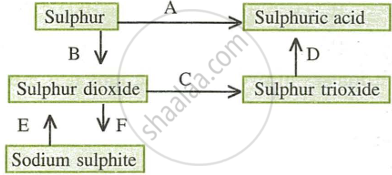Advertisements
Advertisements
Question

- Name the catalyst which helps in the conversion of sulphur dioxide to sulphur trioxide in step C.
- In the contact process for the manufacture of sulphuric acid, sulphur trioxide is not converted to sulphuric acid by reacting it with water. Instead a two-step procedure is used. Write the equations for the two steps involved in D.
- What type of substance will liberate sulphur dioxide from sodium sulphite in step E?
- Write the equation for the reaction by which sulphur dioxide is converted to sodium sulphite in step F.
Solution
- The catalyst that helps in the conversion of sulphur dioxide to sulphur trioxide in step C is Vanadium pentoxide.
- The two steps for the conversion of sulphur trioxide to sulphuric acid are:
- \[\ce{SO3 + H2SO4 -> H2S2O7}\]
- \[\ce{H2S2O7 + H2O -> 2H2SO4}\]
- The substance that will liberate sulphur dioxide in step E is dilute sulphuric acid \[\ce{H2SO4}\].
- The equation for the reaction by which sulphur dioxide is converted to sodium sulphite in step F is:
- \[\ce{SO2 + 2NaOH -> Na2SO3 + H2O}\]
- \[\ce{Na2O + SO2 -> Na2SO3}\]
RELATED QUESTIONS
State one relevant observation for given reactions:
Action of concentrated Sulphuric acid on hydrated copper sulfate
State your observations when Concentrated Sulphuric acid is added to Sugar Crystals
Distinguish between the given pairs of compounds using the test given within brackets:
Dilute sulphuric acid and dilute hydrochloric acid (using barium chloride solution)
Name the products formed when hot and concentrated sulphuric acid reacts with Copper.
Give reason for the following:
Ammonia gas cannot be dried by passing through concentrated sulphuric acid.
How will you distinguish between dilute H2SO4 and conc. H2SO4 ?
A, B, C and D summarize the properties of sulphuric acid depending on whether it is dilute or concentrated. Choose the property (A, B, C or D), depending on which is relevant to each of the preparations (i) to (ii).
A. Dilute acid (typical acid properties)
B. Non-volatile acid
C. Oxidizing agent
D. Dehydrating agent
(i) Preparation of hydrogen chloride.
(ii) Preparation of ethane from ethanol
(iii) Preparation of copper sulphate from copper oxide.
Give balanced chemical equation to prepare the following salt:
Lead sulphate from lead carbonate
Identify the gas evolved and give the chemical test in the following case:
Dilute hydrochloric acid reacts with iron (II) sulphide.
Name the acid formed when sulphur dioxide dissolves in water.
